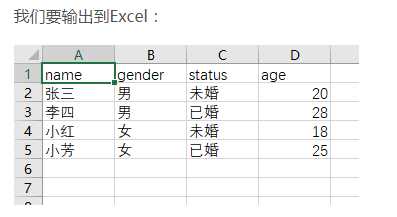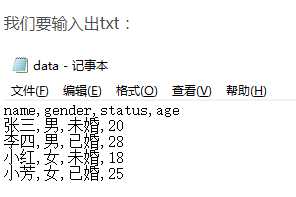python例子,,list1 = [[
python例子,,list1 = [[


list1 = [[‘张三‘,‘男‘,‘未婚‘,20],[‘李四‘,‘男‘,‘已婚‘,28],[‘小红‘,‘女‘,‘未婚‘,18],[‘小芳‘,‘女‘,‘已婚‘,25]]output = open(‘data.xls‘,‘w‘,encoding=‘gbk‘)output.write(‘name\tgender\tstatus\tage\n‘)for i in range(len(list1)): for j in range(len(list1[i])): output.write(str(list1[i][j])) #write函数不能写int类型的参数,所以使用str()转化 output.write(‘\t‘) #相当于Tab一下,换一个单元格 output.write(‘\n‘) #写完一行立马换行output.close()View Code


list1 = [[‘张三‘,‘男‘,‘未婚‘,20],[‘李四‘,‘男‘,‘已婚‘,28],[‘小红‘,‘女‘,‘未婚‘,18],[‘小芳‘,‘女‘,‘已婚‘,25]]output = open(‘data.txt‘,‘w‘,encoding=‘gbk‘)output.write(‘name,gender,status,age\n‘)for row in list1: rowtxt = ‘{},{},{},{}‘.format(row[0],row[1],row[2],row[3]) output.write(rowtxt) output.write(‘\n‘)output.close()View Code组合
combinations:不考虑顺序的排列组合import itertoolsprint list(itertools.combinations([1,2,3,4],3))[(1, 2, 3), (1, 2, 4), (1, 3, 4), (2, 3, 4)]permutations:考虑顺序的排列组合import itertoolsprint list(itertools.permutations([1,2,3,4],2)) #第二个参数2表示要选几个对象[(1, 2), (1, 3), (1, 4), (2, 1), (2, 3), (2, 4), (3, 1), (3, 2), (3, 4), (4, 1), (4, 2), (4, 3)]
from itertools import productl = [1, 2, 3]print (list(product(l, l)))print (list(product(l, repeat=3)))结果:[(1, 1), (1, 2), (1, 3), (2, 1), (2, 2), (2, 3), (3, 1), (3, 2), (3, 3)][(1, 1, 1), (1, 1, 2), (1, 1, 3), (1, 2, 1), (1, 2, 2), (1, 2, 3), (1, 3, 1), (1, 3, 2), (1, 3, 3), (2, 1, 1), (2, 1, 2), (2, 1, 3), (2, 2, 1), (2, 2, 2), (2, 2, 3), (2, 3, 1), (2, 3, 2), (2, 3, 3), (3, 1, 1), (3, 1, 2), (3, 1, 3), (3, 2, 1), (3, 2, 2), (3, 2, 3), (3, 3, 1), (3, 3, 2), (3, 3, 3)]
python例子
相关内容
- python min函数,,一.python m
- 利用python打印特殊符号,,1、方法一,调用字符
- 05 Windows安装python3.6.4+pycharm环境,,windows安装p
- python:变量,, 一个python初
- 2019第一期《python测试开发》课程,10月13号开学,,201
- python(time/random模块),,一、Time模块1.
- kmeans与kmeans++的python实现,,一.kmeans聚类
- Python小白学习之路(四)——第一次练习题,,写在前面
- 【4】python_基础_集合、json模块、函数,,1 集合(天生去
- python_004days,,2018-07-05

评论关闭